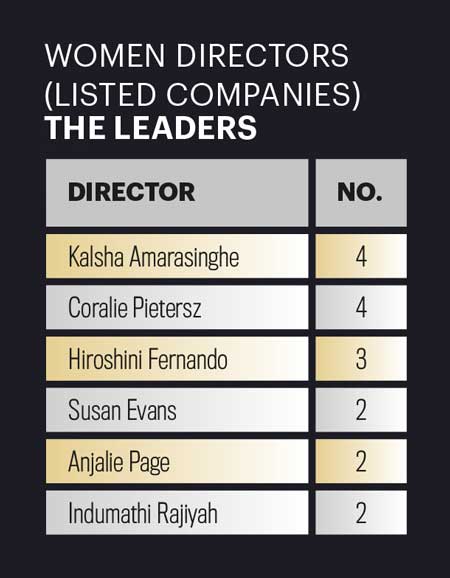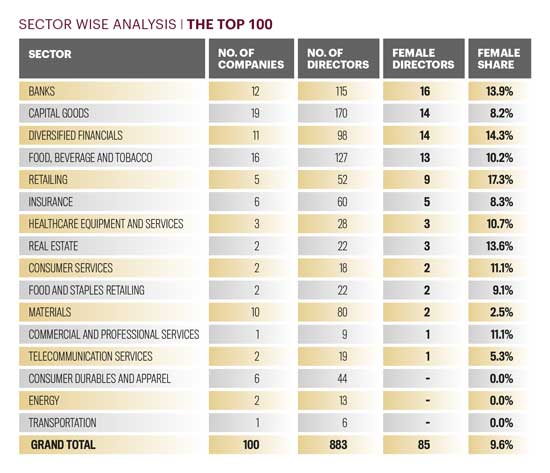BOARD BALANCE | 2021/22
Gender Scorecard
There’s still a dearth of women in the boardrooms of Sri Lanka’s listed companies
“Collective capacity, described by the UN Secretary-General as humanity’s greatest resource, is severely constrained when half of humanity – women and girls – are denied the right to freedom from discrimination,” observes the International Labour Organization, in its opening remarks of the preface to the ILO Action Plan for Gender Equality 2022-25.
It continues in the introduction to the report: “In today’s exceptionally challenging context, gender equality and women’s empowerment in the world of work are key to achieving the vision of ‘Leave no one behind’ in the 2030 Agenda for Sustainable Development (2030 Agenda) and to meeting all the Sustainable Development Goals (SDGs).”
According to the latest (2022) Women in the Workplace report compiled by McKinsey in partnership with LeanIn.Org, data from 333 participating organisations from corporate America revealed what was described as being amid a ‘Great Breakup,’ and that companies need to go beyond table stakes to ensure significant and sustainable progress toward gender equality.
McKinsey observes: “Women are demanding more from work, and they’re leaving their companies in unprecedented numbers to get it. Women leaders are switching jobs at the highest rates we’ve ever seen – and at higher rates than men in leadership. That could have serious implications for companies. Women are already significantly underrepresented in leadership.”
The World Economic Forum’s (WEF) Global Gender Gap Index 2022 ranked Sri Lanka 110th (2021’s ranking was 116) – once again behind Bangladesh (71) and Nepal (96), but ahead of the Maldives (117), India (135) and Pakistan (145).
As for the rankings within the sub-indices of economic participation and opportunity, educational attainment, health and survival, and political empowerment, Sri Lanka was ranked 122nd, 80th, 1st (sharing this ranking with 27 other countries) and 93rd respectively.
According to the Sri Lanka Labour Force Survey 2nd Quarter – 2022 bulletin, the recorded female labour force participation stood at slightly over 32 percent. This is an improvement to the female “ employment rates registered for the second quarter of 2021 (30.9%) and 31.6 percent for the same three months of the prior year.
The employment rate for men in the second quarter of 2022 was more than twice that of women – i.e. 70.9 percent.
Unemployment rates for women in the second quarter of 2022 recorded a decline to 6.5 percent from 7.7 in the comparable period of 2021 and 8.2 percent in the same period in 2020. It is of interest to note that unemployment rates for men stood at 3.7 percent (Q2 2022), 3.8 percent (Q2 2021) and 4.1 percent (Q2 2020).
Global Gender Diversity 2022, released by Altrata based on data from BoardEx, reveals that “gender diversity at the top of a company appears to make a real difference: entities with female CEOs or chairs tend to have greater gender diversity on their boards and leadership teams than those with male CEOs or chairs.”
The report also found that only five percent of CEOs are female while women account for under a third of board seats “among the corporations of the major indices across 20 of the world’s major economies.”
It also notes that “this reflects the continued underrepresentation of women in top corporate management positions.”
Here in Sri Lanka, only one LMD 100 corporate has a board comprising a majority (over 50%) of women, and a mere five have boards with 26-50 percent female representation. By comparison, 45 LMD 100 corporates have all male boards of directors.
An LMD 100 analysis for financial year 2021/22 considered the number and share of directorships held by women. Additionally, it provides an insight into female representation on company boards in the context of 16 business sectors including banking, diversified financials, commercial and professional services, insurance, telecommunication services and retailing.
It is a fair say that based on the data, there’s room for improvement in the gender mix of the boards of LMD 100 companies.
“Only one LMD 100 corporate has a board comprising a majority (over 50%) of women








